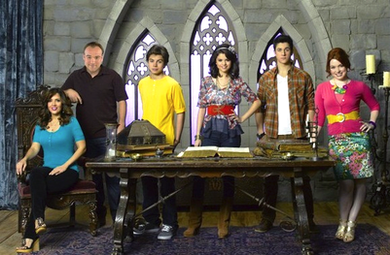- The Festival of Frugality #278 The Pure Peer Pressure Edition is up. All of your friends are reading it. http://bit.ly/aqkn4K #
- RT @princewally: Happy StarWars Day!: princewally's world http://goo.gl/fb/rLWAA #
- Money Hacks Carnival #114 – Hollywood Edition http://bit.ly/dxU86w (via @nerdwallet) #
- I am the #1 google hit for "charisma weee". Awesome. #
Selena Gomez: Can Child Stars Make It As Adults?
Selena Gomez is no longer the innocent yet rebellious Alex from Disney’s hit show Wizards of Waverly Place. In fact, the quirky and wholesome child star who was beloved by so many young women has now become a scantily

clad pop star that is singing risque lyrics to her on again off again pop star boyfriend Justin Beiber. Her transition to adult stardom has not been an easy one, and many believe that her role in “Spring Breakers” is a sign that she has officially entered adulthood and kissed her teen-friendly role preference in the past. But unlike other famous Disney child stars like Lindsey Lohan and Britney Spears, Gomez has had a relatively smooth path to adult stardom with only minor bumps in the road. But many people are asking themselves whether or not child stars can actually make it as adults, or whether their career is over once their cute phase stages.
Child stars are aware of the fact that they are always being watched. They become the idols of their young fans, and these young idols rely a lot on their cuteness to become a celebrity. But transitioning from a cute kid to a talented adult actor can be a difficult feat. Not only does the star have to earn a new fan base, they also must find a new identity and decide which types of roles they are willing to take now that they are a mature adult able to make their own decisions. Sometimes, even children who do not fall into the drug and alcohol trap, find it difficult when they are given control of their own careers without their guardian’s rules.
The Public is Less Receptive to a Child Star Turned Adult Star
Die hard Wizards of Waverly Place will always see Selena Gomez as the lovable yet comedic Alex Russo. While this was her most popular role, it is the role that will makes her transition into more mature roles difficult. The public is less receptive to an adult Selena Gomez, clad in bra tops and short shorts, because they do not realize that she has matured. When the public shuns a child star for taking on more adult roles, the star simply is not sought after for movies and sitcoms. Young female child stars tend to be judged much more than their male counterparts. In fact, Justin Timberlake and Ryan Gosling are both very successful in the acting scene, and they were both Mouseketeers.
It is possible for a child star to make it as a adult, but the person must have thick skin and be prepared for a publicly criticized transition. Many child stars simply choose to retire once they have outgrown the ability to take on youthful roles, and others are not mentally prepared for the scrutiny they will face. Ultimately, a child star can have a successful career in stardom as an adult if the public is ready for the transition.
Getting Out of Bed

- Image by Wha’ppen via Flickr
Why do you get out of bed in the morning? Is it so you can exercise the privilege of spending 8 hours in a cubicle?
I didn’t think so.
In Okinawa, it’s call the ikigai. In Costa Rica, it’s the plan de vida. It’s your sense of purpose–the reason you get out of bed in the morning. In these cultures, having a strong ikigai can be directly correlated to a statistically extreme lifespan*. All around the world, the plan de vida is the single factor most likely to cause someone to feel they have lived a fulfilled life.
Do you know your ikigai?
For some people, their plan de vida is to successfully raise their children, then their grandchildren. For others, it is charity. Some folks are serial entrepreneurs, always looking for the next deal, the next business. For still others, it is a collection or an urge to travel. There are even some whose sole reason for getting out of bed(other than potty breaks) is work.
The last category is most common with teachers, soldiers, and police. The problem with wrapping so much of your identity up in your profession is retirement. What do you do when your ikigai–your reason to wake up–goes away? In Okinawa, teachers and police tend to have very short retirements because they lose their reason to for living.
What is your plan de vida, your passion? What drives you to keep going? Do you live to write, or to raise your children? Do you <shudder> live solely for someone else’s happiness? When you find it, it will resonate as “this is you”. Finding it is a deep soul-searching, not a light-hearted explanation or a new fad.
Your reasons can, and should, change over time. You can’t live for raising your children years after they have grown up and moved away. Finding this one factor in your life can be the thing that leaves you on your deathbed looking back with a smile instead of regret.
What is your plan de vida?
* From The Blue Zones: Lessons for Living Longer From the People Who’ve Lived the Longest
Playing For Blood
Kris at Every Tips and Thoughts wrote a post about games and letting her kids win feeling bad about winning. I disagree. This post is an expansion of my comment there.
When we play games in my house, we play for blood. I’ve never let my kids win and they know it. From the first time the kids attempt Memory, they know they’ve got to earn a win against Mom and Dad. They know if they lose, they must do so gracefully. If they pout or cry, they lose game privileges for a while. I demand good sportsmanship, win or lose.
To be clear, my kids are 3, 4, and 11 and they are all held to the same standards of sportsmanship. Win or lose, they will do so gracefully. There will be no temper tantrums when they are Sorry’d and no pouting when the Queen is captured.
It took my son almost 3 years to beat me at chess. When it finally happened, he was almost as proud as I was and still talks about it 5 years later.
It’s not much fun playing games with his friends. They were coddled and expect to win everything. I have to take away game privileges just like I do for my 3 year old. They hate that because we have the coolest board games. Nobody else has games that involve zombies or disembodied brains.
What has the result been?
My kids love playing games. This week, my oldest has been teaching his sisters how to play Life. When he visits his friends, he’s as likely to bring a board game as an electronic game. He’s got a good mind for strategy, and I can’t remember the last time he pouted when I tromped him.
My 4 year old hasn’t mastered gamesmanship yet, but she will. When I threaten to put the game away, she wipes her eyes, and keeps playing, even if her jaw is chattering. She knows what is expected and works to live up to it.
Both of the older kids are competitive. They’ve never had a win handed to them, and they have each had wins they had to work for, and they know how it feels to win and earn it.
The youngest doesn’t care if she wins, she’s just happy to play. In my experience, the competitive gameplay gene doesn’t activate until 4.
In my mind, the real world won’t hand them any wins, so I might as well start teaching them how to work for it now.
How about you? Do you let your kids win, or do you teach them that all games are bloodsports?
Focusing on the Now

My company uses a service called KnowYourCompany, that sends three emails each week to the entire staff. Each email asks a question that the staff can either respond to publicly, or just to the company leadership team.
The questions follow a formula.
On Monday, we get an email asking what we are working on. This allows us to see what everyone is doing, and in theory, makes offering your skills easier to do because you can see what you might be able to help with.
On Wednesday, the question is something about the company or our interaction with the company. One week this question was as simple as “Are there any company policies that aren’t completely clear?”
On Friday, the question is more personal. It’s a getting-to-know-each-other question. Last Friday’s question was “What’s something you want to do in the next year that you’ve never done before?”
I found that I don’t have an answer.
Right now, I don’t have any long-term goals. Recently, my personal life has been complicated enough that the idea of planning for later this year–much less the next 5 or 10 years–is more than I can deal with.
My side hustle goals are focused entirely on what needs to happen in the next week. Work goals are only a month out. My personal goals involve making it through the next few days without letting anything collapse.
Sometimes, life kicks you in the crotch so hard, you have to let the future worry about itself while you focus on what’s happening right now. Without a functional present, the future doesn’t matter. You have to focus on the Now first, or everything else evaporates.
It’s not a great situation, but it is an interesting perspective. I’ve spent so much of the last decade focusing on what comes next that what’s happening right now has suffered.
Focus on Now. Sometimes, What’s Next can take care of itself for a while.
The High Cost of Keeping Richard Ramirez in Prison

Serial killers in the United States often gain cult status due to their strange courtroom antics and dramatic personalities. Recently deceased death row inmate Richard Ramirez was definitely one of the most famous serial killers of all time before he passed away of liver failure in California’s San Quentin State Prison.
After a dramatic arrest in 1985 in East Los Angeles by residents who recognized Ramirez from photographs displayed all over the news, Ramirez would sit in jail for years while awaiting a trial that finally began in 1989. There would be no more expensive trial in the history of Los Angeles County except for the O.J. Simpson trial that occurred a few years later.
At a cost of $1.8 million dollars, Los Angelinos would pay dearly for the privilege of trying Ramirez in a court of law. Incredibly, however, this massive sum wasn’t the only cost associated with this vicious serial killer. Because he was sentenced to death and due to the incredibly long appeals process associated with death row inmates, Ramirez sat in jail for over two decades without any fear of actually being put to death by the state of California.
Over the past hundred years, the number of individuals incarcerated in the United States has ballooned from a few hundred thousand people to almost 2.5 million prisoners. The most expensive people to incarcerate are death row inmates, who sit in a type of solitary confinement for decades. A moratorium on future executions in California has ensured that inmates like Ramirez have been costing taxpayers millions of dollars for housing and appeals with no likelihood of being put to death.
According to the American Civil Liberties Union, there are around 700 people sitting on death row in California, which require a massive investment of tax dollars. The state’s ongoing budget crisis and inability to balance its budget has put great strain on the prison system to house so many death row inmates at such an incredible cost.
Richard Ramirez’s untimely death at the age of 53 and his decades-long residency within a state prison brings to light a disturbing fact: more inmates die of natural causes while on death row than are actually put to death. Whether support for the death penalty exists or not, the billions of dollars spent by the state to keep inmates on death row has resulted in just 13 executions since the late 1970s.
A study in 2011 that was conducted by a judge and professor in the state suggested that California has spent over $4 billion since the death penalty was reinstituted. Out of those funds spent, at least a billion dollars was used for housing and incarceration of the inmates, including serial killers like Richard Ramirez.
A further study presented by the Commission on the Fair Administration of Justice in 2008 suggested that keeping the system intact with inmates on death row would cost around $137 million dollars a year. On the other hand, if California was to commute those death sentences to life in prison and abolish the death penalty, the yearly cost would drop to $11.5 million a year.
Offering the families of victims of death penalty-worthy crimes the chance to see a killer or other criminal experience the ultimate punishment may offer some sort of closure. Unfortunately, with the expectation that individuals on death row are more likely to die of natural causes than be put to death in California, the implementation of the death penalty in the state must be reexamined.







